Financial Modeling and Analysis: CISCO's Performance vs Industry
VerifiedAdded on 2023/01/23
|8
|1219
|73
Report
AI Summary
This report evaluates Cisco's financial performance against its industry peers using financial modeling techniques. It includes an analysis of Cisco's stock performance compared to the industry index, revealing that Cisco is currently providing higher returns. The report also examines key financial ratios, such as capital efficiency, profitability, and investment ratios, comparing them to industry averages. The analysis indicates that Cisco's capital efficiency and investment ratios are generally stronger than the industry, while profitability ratios show mixed results. The report concludes that Cisco's current financial strength is better than the industry average, supported by both stock price movement and financial ratio analysis. Desklib provides access to this and other solved assignments for students.
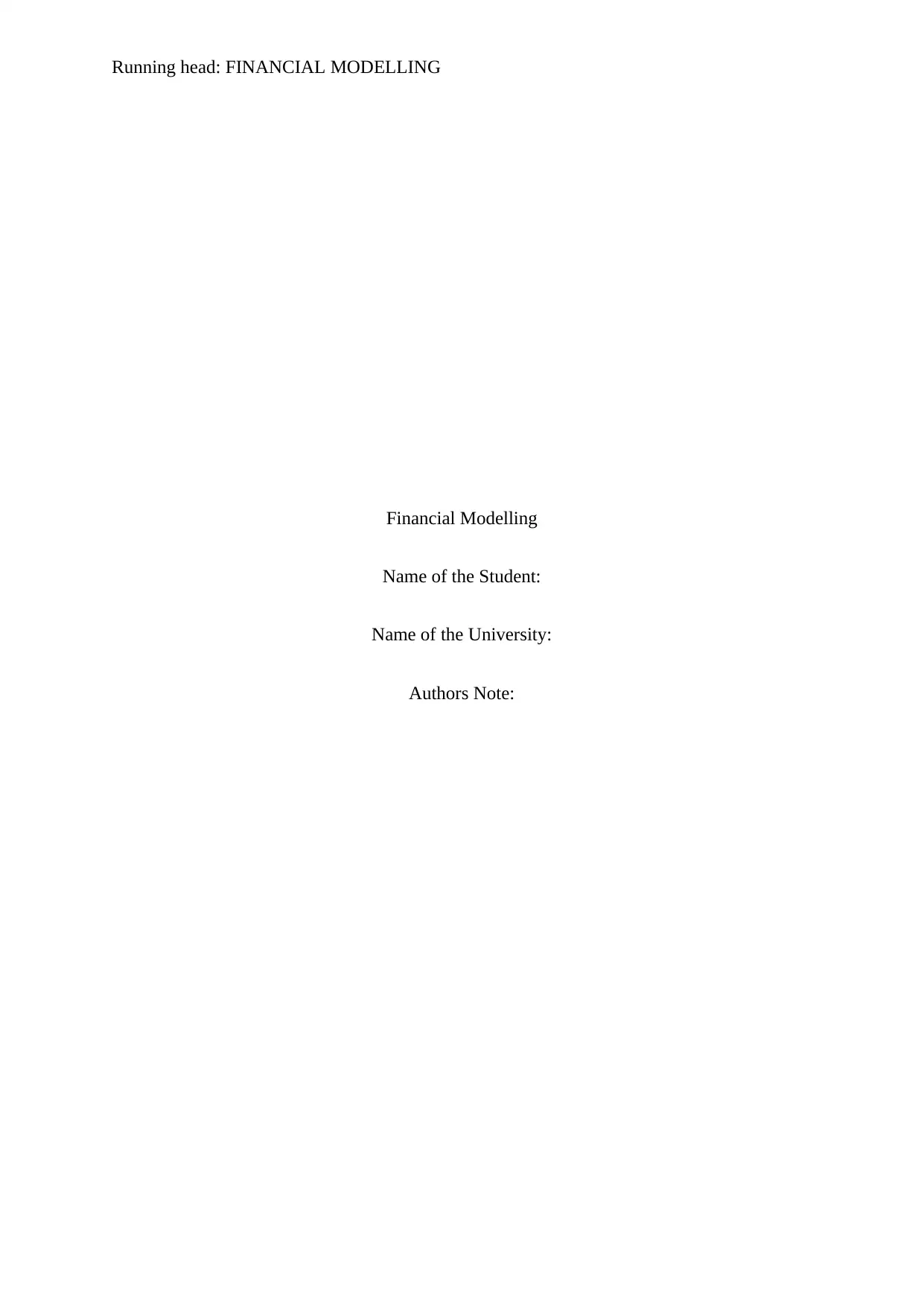
Running head: FINANCIAL MODELLING
Financial Modelling
Name of the Student:
Name of the University:
Authors Note:
Financial Modelling
Name of the Student:
Name of the University:
Authors Note:
Paraphrase This Document
Need a fresh take? Get an instant paraphrase of this document with our AI Paraphraser
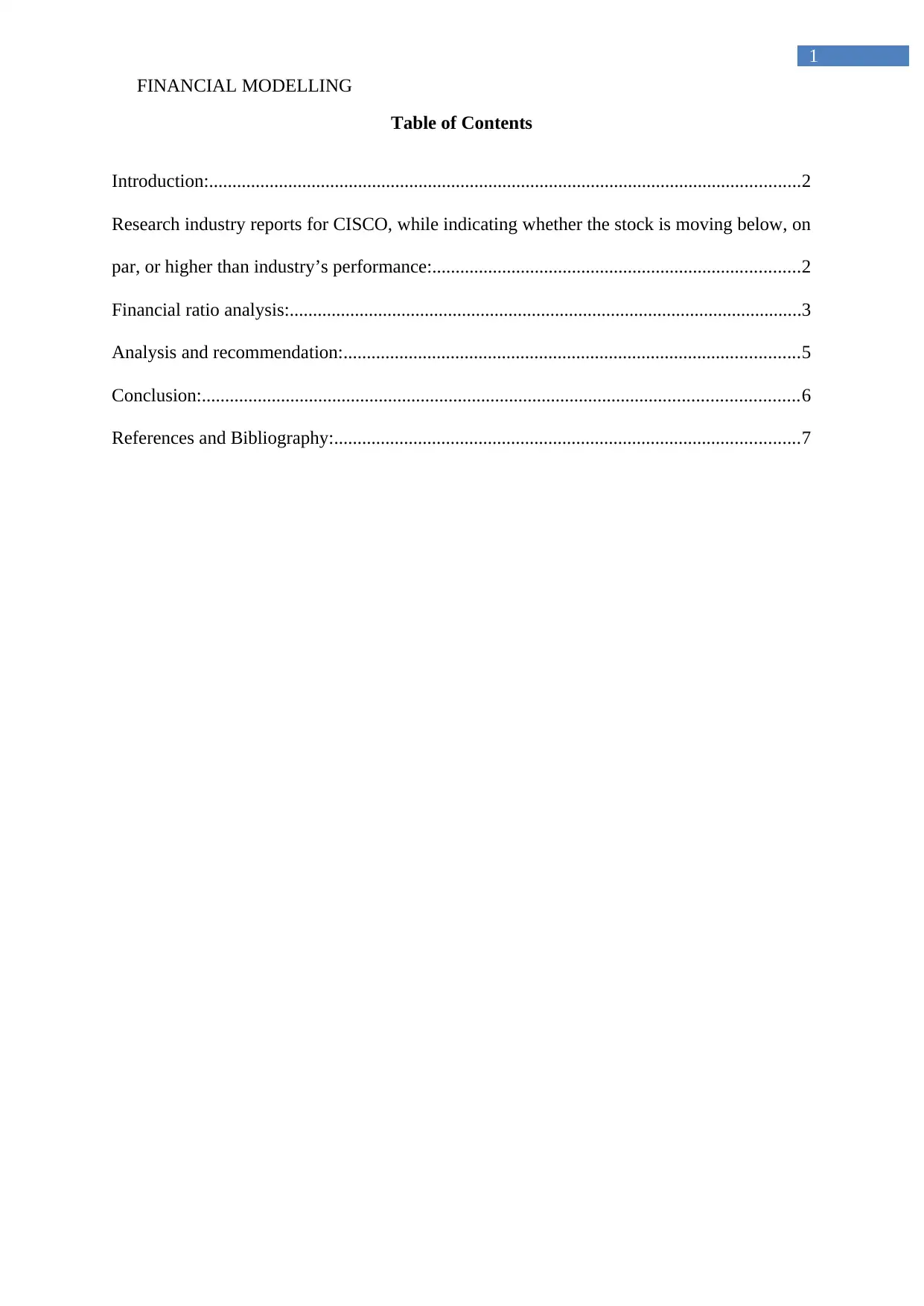
FINANCIAL MODELLING
1
Table of Contents
Introduction:...............................................................................................................................2
Research industry reports for CISCO, while indicating whether the stock is moving below, on
par, or higher than industry’s performance:...............................................................................2
Financial ratio analysis:..............................................................................................................3
Analysis and recommendation:..................................................................................................5
Conclusion:................................................................................................................................6
References and Bibliography:....................................................................................................7
1
Table of Contents
Introduction:...............................................................................................................................2
Research industry reports for CISCO, while indicating whether the stock is moving below, on
par, or higher than industry’s performance:...............................................................................2
Financial ratio analysis:..............................................................................................................3
Analysis and recommendation:..................................................................................................5
Conclusion:................................................................................................................................6
References and Bibliography:....................................................................................................7
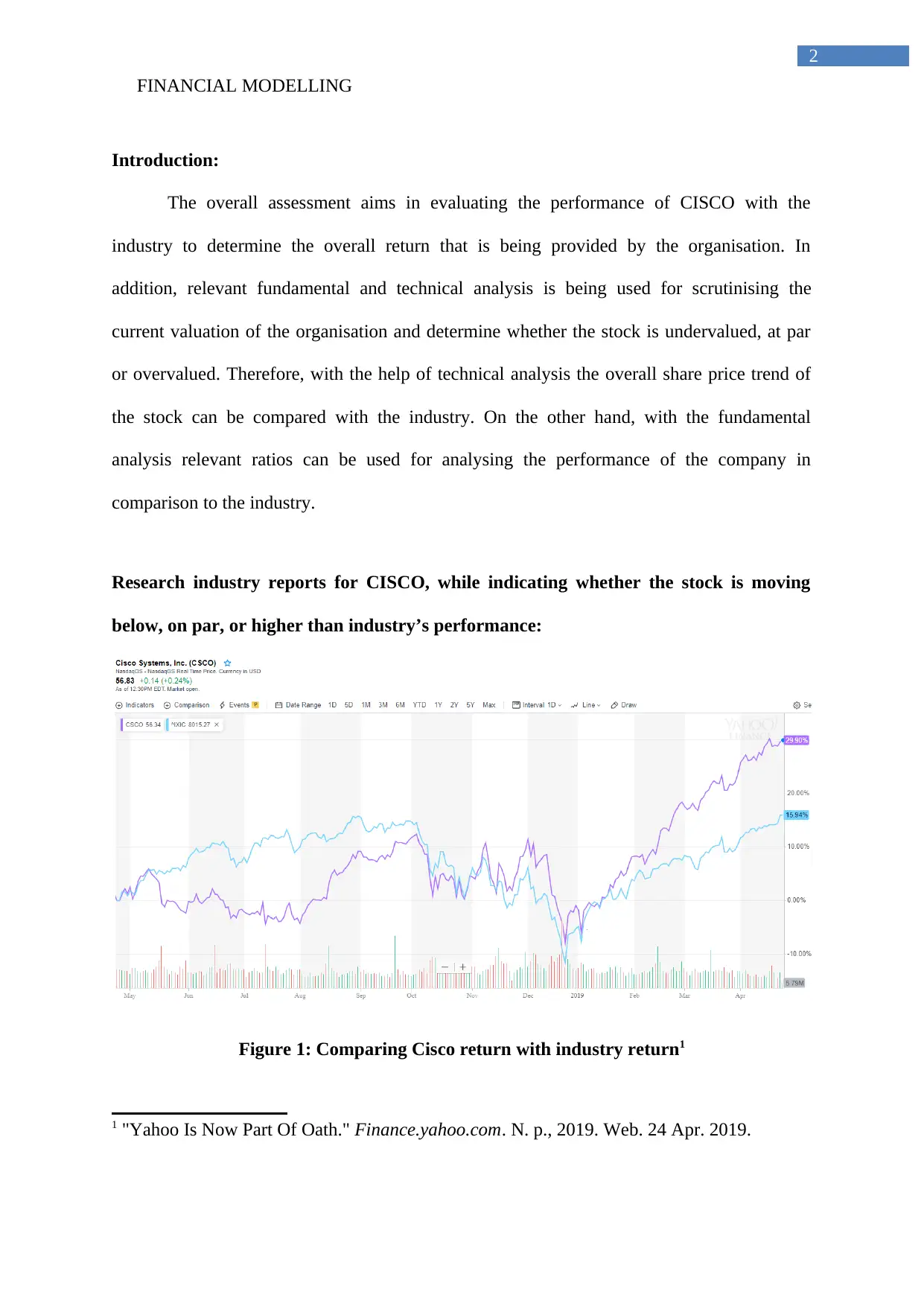
FINANCIAL MODELLING
2
Introduction:
The overall assessment aims in evaluating the performance of CISCO with the
industry to determine the overall return that is being provided by the organisation. In
addition, relevant fundamental and technical analysis is being used for scrutinising the
current valuation of the organisation and determine whether the stock is undervalued, at par
or overvalued. Therefore, with the help of technical analysis the overall share price trend of
the stock can be compared with the industry. On the other hand, with the fundamental
analysis relevant ratios can be used for analysing the performance of the company in
comparison to the industry.
Research industry reports for CISCO, while indicating whether the stock is moving
below, on par, or higher than industry’s performance:
Figure 1: Comparing Cisco return with industry return1
1 "Yahoo Is Now Part Of Oath." Finance.yahoo.com. N. p., 2019. Web. 24 Apr. 2019.
2
Introduction:
The overall assessment aims in evaluating the performance of CISCO with the
industry to determine the overall return that is being provided by the organisation. In
addition, relevant fundamental and technical analysis is being used for scrutinising the
current valuation of the organisation and determine whether the stock is undervalued, at par
or overvalued. Therefore, with the help of technical analysis the overall share price trend of
the stock can be compared with the industry. On the other hand, with the fundamental
analysis relevant ratios can be used for analysing the performance of the company in
comparison to the industry.
Research industry reports for CISCO, while indicating whether the stock is moving
below, on par, or higher than industry’s performance:
Figure 1: Comparing Cisco return with industry return1
1 "Yahoo Is Now Part Of Oath." Finance.yahoo.com. N. p., 2019. Web. 24 Apr. 2019.
⊘ This is a preview!⊘
Do you want full access?
Subscribe today to unlock all pages.

Trusted by 1+ million students worldwide
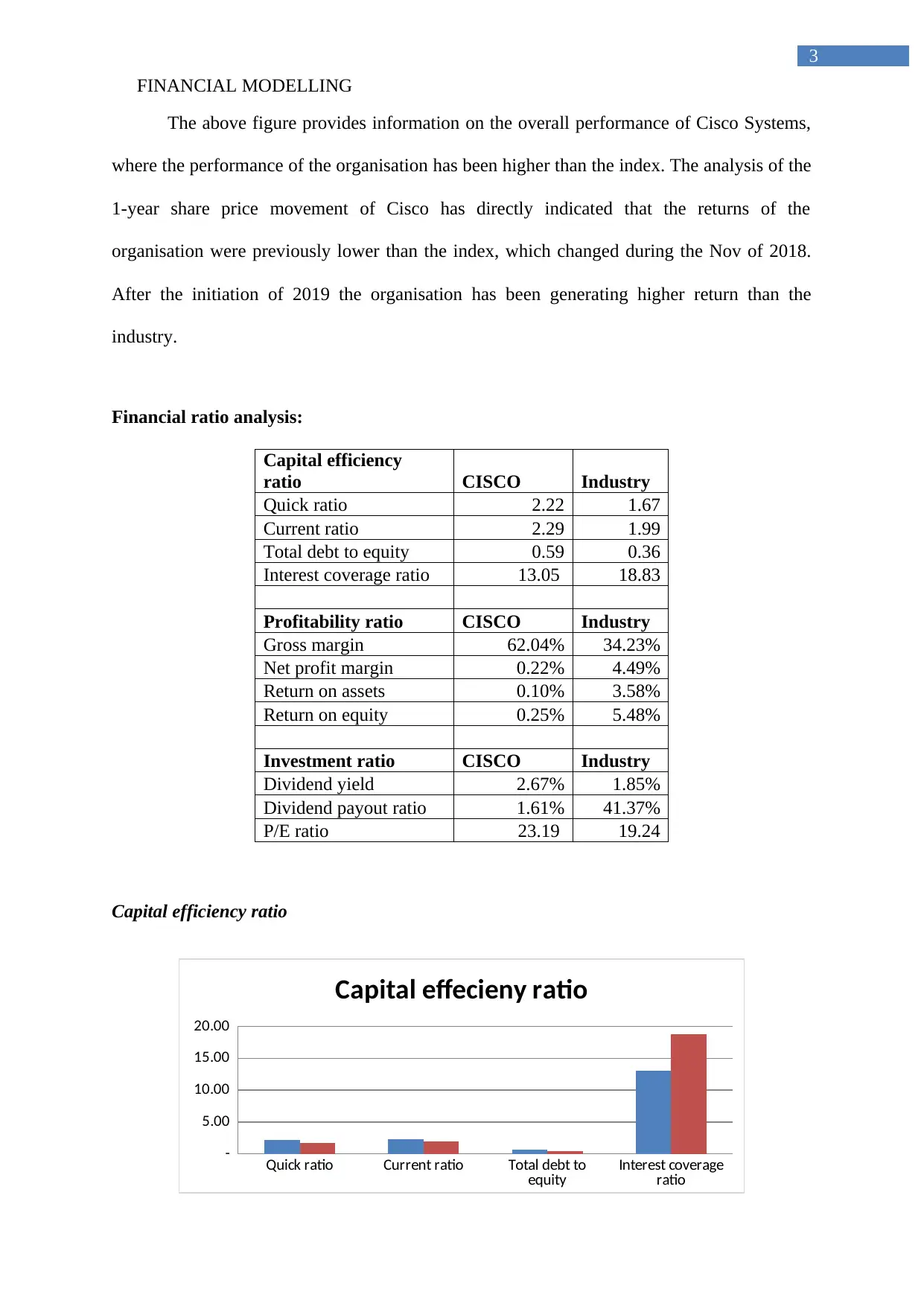
FINANCIAL MODELLING
3
The above figure provides information on the overall performance of Cisco Systems,
where the performance of the organisation has been higher than the index. The analysis of the
1-year share price movement of Cisco has directly indicated that the returns of the
organisation were previously lower than the index, which changed during the Nov of 2018.
After the initiation of 2019 the organisation has been generating higher return than the
industry.
Financial ratio analysis:
Capital efficiency
ratio CISCO Industry
Quick ratio 2.22 1.67
Current ratio 2.29 1.99
Total debt to equity 0.59 0.36
Interest coverage ratio 13.05 18.83
Profitability ratio CISCO Industry
Gross margin 62.04% 34.23%
Net profit margin 0.22% 4.49%
Return on assets 0.10% 3.58%
Return on equity 0.25% 5.48%
Investment ratio CISCO Industry
Dividend yield 2.67% 1.85%
Dividend payout ratio 1.61% 41.37%
P/E ratio 23.19 19.24
Capital efficiency ratio
Quick ratio Current ratio Total debt to
equity Interest coverage
ratio
-
5.00
10.00
15.00
20.00
Capital effecieny ratio
3
The above figure provides information on the overall performance of Cisco Systems,
where the performance of the organisation has been higher than the index. The analysis of the
1-year share price movement of Cisco has directly indicated that the returns of the
organisation were previously lower than the index, which changed during the Nov of 2018.
After the initiation of 2019 the organisation has been generating higher return than the
industry.
Financial ratio analysis:
Capital efficiency
ratio CISCO Industry
Quick ratio 2.22 1.67
Current ratio 2.29 1.99
Total debt to equity 0.59 0.36
Interest coverage ratio 13.05 18.83
Profitability ratio CISCO Industry
Gross margin 62.04% 34.23%
Net profit margin 0.22% 4.49%
Return on assets 0.10% 3.58%
Return on equity 0.25% 5.48%
Investment ratio CISCO Industry
Dividend yield 2.67% 1.85%
Dividend payout ratio 1.61% 41.37%
P/E ratio 23.19 19.24
Capital efficiency ratio
Quick ratio Current ratio Total debt to
equity Interest coverage
ratio
-
5.00
10.00
15.00
20.00
Capital effecieny ratio
Paraphrase This Document
Need a fresh take? Get an instant paraphrase of this document with our AI Paraphraser

FINANCIAL MODELLING
4
The overall capital efficiency ratio of Cisco is considered to be higher than the
industry, where the quick and the current ratio only beats the industry, where the both the
interest coverage ratio and total debt is lower. The current debt composition of the company
is higher than the industry average, which is the main reason why its overall interest coverage
ratio is lower, as maximum of its income is being eroded by the finance cost2. There is
relevantly no difference between the current asnd quick ratio, as the company deals in target
market, where maximum of its products is being sold and low inventory is left after sales.
Profitability ratio
Gross margin Net profit margin Return on assets Return on equity
0.00%
10.00%
20.00%
30.00%
40.00%
50.00%
60.00%
70.00%
Profitability ratio
The profitability ratios states about the low revenue generation capability of the
company. Cisco only beats the industry on gross margin, whereas it has low net profit
margin, return on assets and return on equity in comparison to the industry. The cost of cost
of the organotin is relevantly low, which provides the company with adequate revenue to
support its administrative expenses3. However, the rising operating expenses such as research
and development cost, finance cost and provision of income tax has mainly deteriorated the
net profits of the financial year of 2018. Thus, without the provision for tax, which directly
2 "Annual Reports." Cisco. N. p., 2019. Web. 24 Apr. 2019.
3 "Annual Reports." Cisco. N. p., 2019. Web. 24 Apr. 2019
4
The overall capital efficiency ratio of Cisco is considered to be higher than the
industry, where the quick and the current ratio only beats the industry, where the both the
interest coverage ratio and total debt is lower. The current debt composition of the company
is higher than the industry average, which is the main reason why its overall interest coverage
ratio is lower, as maximum of its income is being eroded by the finance cost2. There is
relevantly no difference between the current asnd quick ratio, as the company deals in target
market, where maximum of its products is being sold and low inventory is left after sales.
Profitability ratio
Gross margin Net profit margin Return on assets Return on equity
0.00%
10.00%
20.00%
30.00%
40.00%
50.00%
60.00%
70.00%
Profitability ratio
The profitability ratios states about the low revenue generation capability of the
company. Cisco only beats the industry on gross margin, whereas it has low net profit
margin, return on assets and return on equity in comparison to the industry. The cost of cost
of the organotin is relevantly low, which provides the company with adequate revenue to
support its administrative expenses3. However, the rising operating expenses such as research
and development cost, finance cost and provision of income tax has mainly deteriorated the
net profits of the financial year of 2018. Thus, without the provision for tax, which directly
2 "Annual Reports." Cisco. N. p., 2019. Web. 24 Apr. 2019.
3 "Annual Reports." Cisco. N. p., 2019. Web. 24 Apr. 2019
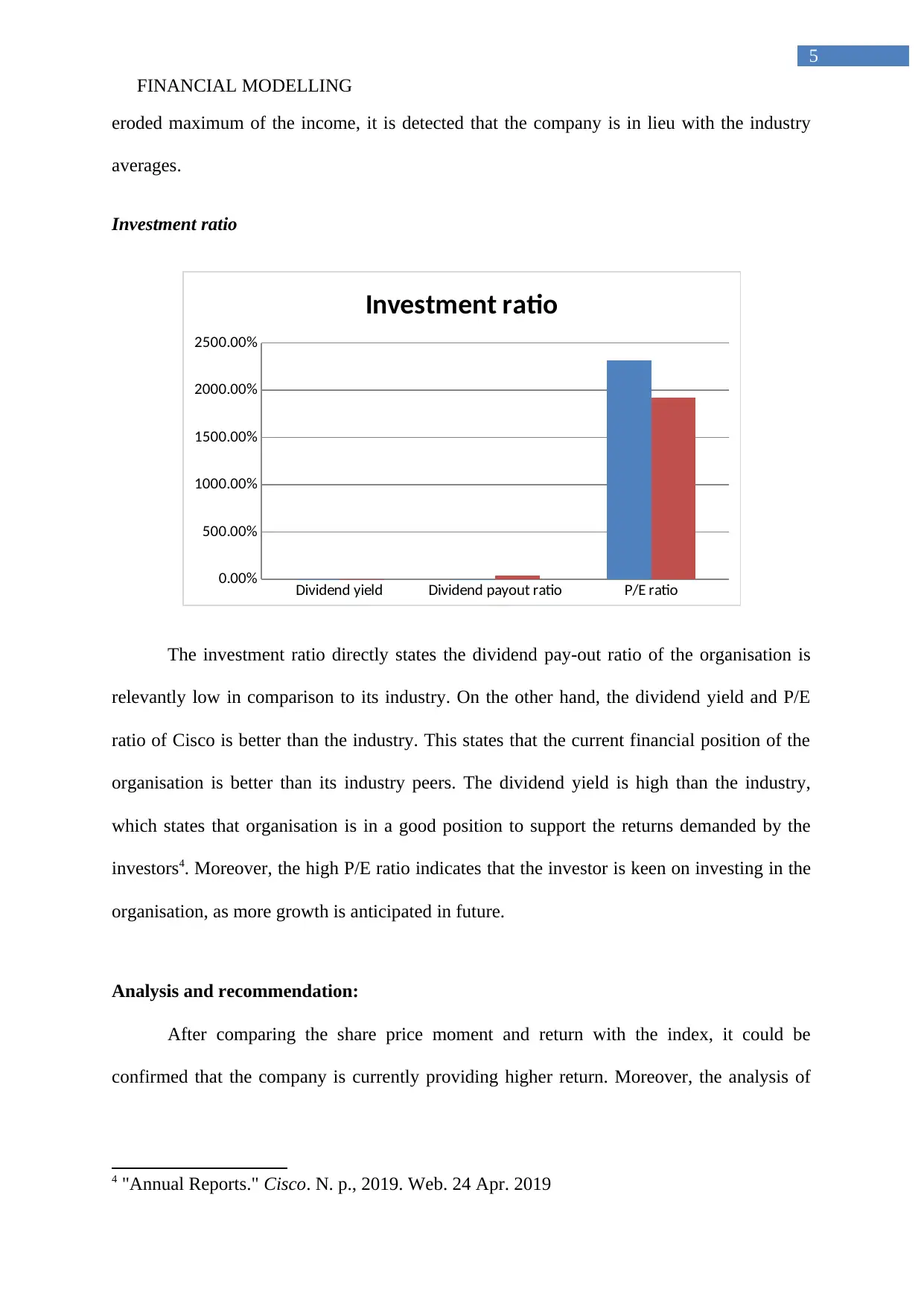
FINANCIAL MODELLING
5
eroded maximum of the income, it is detected that the company is in lieu with the industry
averages.
Investment ratio
Dividend yield Dividend payout ratio P/E ratio
0.00%
500.00%
1000.00%
1500.00%
2000.00%
2500.00%
Investment ratio
The investment ratio directly states the dividend pay-out ratio of the organisation is
relevantly low in comparison to its industry. On the other hand, the dividend yield and P/E
ratio of Cisco is better than the industry. This states that the current financial position of the
organisation is better than its industry peers. The dividend yield is high than the industry,
which states that organisation is in a good position to support the returns demanded by the
investors4. Moreover, the high P/E ratio indicates that the investor is keen on investing in the
organisation, as more growth is anticipated in future.
Analysis and recommendation:
After comparing the share price moment and return with the index, it could be
confirmed that the company is currently providing higher return. Moreover, the analysis of
4 "Annual Reports." Cisco. N. p., 2019. Web. 24 Apr. 2019
5
eroded maximum of the income, it is detected that the company is in lieu with the industry
averages.
Investment ratio
Dividend yield Dividend payout ratio P/E ratio
0.00%
500.00%
1000.00%
1500.00%
2000.00%
2500.00%
Investment ratio
The investment ratio directly states the dividend pay-out ratio of the organisation is
relevantly low in comparison to its industry. On the other hand, the dividend yield and P/E
ratio of Cisco is better than the industry. This states that the current financial position of the
organisation is better than its industry peers. The dividend yield is high than the industry,
which states that organisation is in a good position to support the returns demanded by the
investors4. Moreover, the high P/E ratio indicates that the investor is keen on investing in the
organisation, as more growth is anticipated in future.
Analysis and recommendation:
After comparing the share price moment and return with the index, it could be
confirmed that the company is currently providing higher return. Moreover, the analysis of
4 "Annual Reports." Cisco. N. p., 2019. Web. 24 Apr. 2019
⊘ This is a preview!⊘
Do you want full access?
Subscribe today to unlock all pages.

Trusted by 1+ million students worldwide

FINANCIAL MODELLING
6
the financial ratio with the index also states that the performance of Cisco is higher than the
industry.
Conclusion:
The assessment evaluates the performance of Cisco with the industry to identify
whether it is below, on par, or higher in performance. Relevant financial ratios are also used
to detect the current performance of Cisco and compare it with the industry. The ratio
analysis has indicated that the current financial strength of Cisco is higher than the industry.
Moreover, the confirmation of the higher performance is conducted from the stock price
movement, where the current returns are higher than the index.
6
the financial ratio with the index also states that the performance of Cisco is higher than the
industry.
Conclusion:
The assessment evaluates the performance of Cisco with the industry to identify
whether it is below, on par, or higher in performance. Relevant financial ratios are also used
to detect the current performance of Cisco and compare it with the industry. The ratio
analysis has indicated that the current financial strength of Cisco is higher than the industry.
Moreover, the confirmation of the higher performance is conducted from the stock price
movement, where the current returns are higher than the index.
Paraphrase This Document
Need a fresh take? Get an instant paraphrase of this document with our AI Paraphraser

FINANCIAL MODELLING
7
References and Bibliography:
"Annual Reports." Cisco. N. p., 2019. Web. 24 Apr. 2019.
"Yahoo Is Now Part Of Oath." Finance.yahoo.com. N. p., 2019. Web. 24 Apr. 2019.
Kou, Gang, Yi Peng, and Guoxun Wang. "Evaluation of clustering algorithms for financial
risk analysis using MCDM methods." Information Sciences 275 (2014): 1-12.
Omar, Normah, et al. "Financial statement fraud: A case examination using Beneish model
and ratio analysis." International Journal of Trade, Economics and Finance 5.2 (2014): 184.
Robinson, Thomas R., et al. International financial statement analysis. John Wiley & Sons,
2015.
Vogel, Harold L. Entertainment industry economics: A guide for financial analysis.
Cambridge University Press, 2014.
7
References and Bibliography:
"Annual Reports." Cisco. N. p., 2019. Web. 24 Apr. 2019.
"Yahoo Is Now Part Of Oath." Finance.yahoo.com. N. p., 2019. Web. 24 Apr. 2019.
Kou, Gang, Yi Peng, and Guoxun Wang. "Evaluation of clustering algorithms for financial
risk analysis using MCDM methods." Information Sciences 275 (2014): 1-12.
Omar, Normah, et al. "Financial statement fraud: A case examination using Beneish model
and ratio analysis." International Journal of Trade, Economics and Finance 5.2 (2014): 184.
Robinson, Thomas R., et al. International financial statement analysis. John Wiley & Sons,
2015.
Vogel, Harold L. Entertainment industry economics: A guide for financial analysis.
Cambridge University Press, 2014.
1 out of 8
Related Documents
Your All-in-One AI-Powered Toolkit for Academic Success.
+13062052269
info@desklib.com
Available 24*7 on WhatsApp / Email
![[object Object]](/_next/static/media/star-bottom.7253800d.svg)
Unlock your academic potential
Copyright © 2020–2025 A2Z Services. All Rights Reserved. Developed and managed by ZUCOL.





